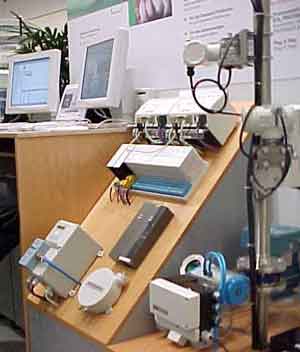ACHEMA: ABB Provides Glimpses of Future Upgrade Paths


ABB's new controller is designed to work with all its other control system families. It also discussed its approach to industrial IT, which features "objects and aspects" data architecture and fundamental plant process models.
Table of Contents
ABB Field Controller
Drivers
Industrial IT
Plant Models
More Changes
When it comes to process automation, ABB Automation faces a problem. It has acquired a broad range of process control technologies and installed user bases over the past decade.
Now, how will it put together all the products and system architectures it has acquired to:
The outlines of an answer were visible this week at ACHEMA, the giant chemical trade show in Frankfurt, Germany. On Tuesday, ABB held a press conference to describe its vision of data "objects and aspects," while at its booth, it displayed its latest digital control system (DCS), the ABB Field Controller 800.
ABB Field Controller(Back to Top)
If the name sounds unfamiliar, it is because it replaces the company's Freelance DCS line. The new controller works with ABB's Symphony, Avand, and Freelance DCS products. ABB expects to introduce compatibility with SattLine, its fourth DCS, within the next couple of weeks.

The ABB 800 also enables Symphony to work through it with any of the other three controllers.
The result effectively helps rationalize ABB's DCS line, which at one time included Advand, Contronic, Freelance, Infi90, Master, Mod, and Symphony. The company's strategy has been to enable its controllers to operate with existing downstream products in other product lines.
The rationalization process has moved forward slowly. ABB chose to bring research and development projects already in the pipeline of the various product lines to market. Still, the ABB 800 is likely to become the company's primary field controller.
The company also appears to have standardized on its Maestro NT (which runs on Windows NT) as its human-system interface (HSI). In addition to the new ABB 800, Maestro now works with Freelance, Symphony, and Advand. ABB expects to make it compatible with SattLine by the end of the year. Maestro presents a common look and feel to engineers and companies working with a variety of ABB systems.
In addition to working well with ABB components, the 800 is compatible with a broad range of standards. These include Profibus-DP, Modbus, Freelance 2000 CAN-I/O-Bus, and Hart. The company plans to expand the range to include Foundation Fieldbus and Offener CAN-Bus.
While showing the future of its consolidated product lines on the convention floor, ABB chose to discuss its vision of "industrial IT" at its press conference.

"Imagine a business enterprise where plant automation, asset optimization, and decision support processes are seamlessly linked in real time," says Dick McAllister, who presented the company's vision for industrial IT.
McAllister, like many others who look at the market, envisions a holistically linked enterprise that embraces everything from the sensors on individual valves up through business systems. He also sees a specific driver.
"Today, the issue is order fulfillment," McAllister explains. "The cycles in the past have been quite long. Whether its the chemical, pulp and paper, or refining industry, it takes months to plan and schedule an order. The inventory need to fulfill this system is quite large."
ABB's goal, he says, is to improve productivity by driving down the cost of inventory and time. The growing high-speed Internet economy makes such responsiveness more important than ever. "We need a tight coupling of the process, plant, and business," McAllister continues. "If we look at applications running in those three environments, they're loosely linked."
McAllister says Industrial IT must meet four criteria to succeed:
Here's where ABB's objects and aspects come in. McAllister envisions objects as virtually anything in a plant, from valves to documents. "If I have an object, it has a number of things on it," he explains.
"These aspects of the object might be P&I diagrams, simulation and control models, operation interactions. We can build on these objects, put together in units and plants to create a consistent data infrastructure. We can now associate them with a number of different types of information -- orders, inventory -- and navigate graphically by relating objects to one another.
If data architecture is an enabling technology for industrial IT, then plant models are critical to its success. "We need very rigorous chemical plant models," says Chester Mroz, president of Zurich-based ABB Automation Group Ltd.'s Petroleum, Chemical and Consumer Industries business area.
"If we can't model plants in real time dynamically, we're going to have problems," he explains. Existing applications with their diverse data architectures do not address the need. Objects and aspects make it easier, but only if a company has dynamic modeling capability.
That's why ABB formed an alliance with PSE, whose gPROMS simulation is a leading dynamic modeling tool. Under the agreement, ABB will license gPROMS for its newer products. The alliance also covers joint product development and consulting contracts.
The results of dynamic modeling can be startling, says Mroz. "We put together some prototypes for a gasoline blending process. By using objects and dynamic modeling, we were able to increase operating margins by three to four times, to 10 c/bbl compared to the 2 c/bbl normally achieved.
Meanwhile, ABB continues to change. As more chemical companies view process hardware as a commodity product, the company will increase its emphasis on software. It seeks to deliver diagnostics and ultimately software functionality over the Web. It also expects to roll out its object and aspect architecture throughout its discrete and robot product lines.
Chester J. Mroz, President, Petroleum, Chemical and Consumer Industries Business Area, ABB Automation Group Ltd., Binzmuhlesrasse 93, PO Box 8131, CH-8050 Zurich, Switzerland. Phone: +41-1-319-62-45. Fax: +41-1-319-63-90.
By Alan S. Brown

